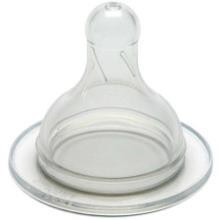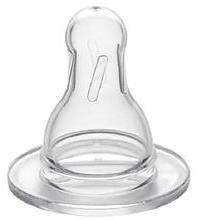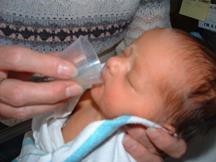Occasionally a baby who is being breastfed will refuse to accept a bottle nipple. This can be especially disconcerting if the mother works outside the home, or needs to be away for more than the interval between feedings. Try these suggestions!
Don’t wait too long
Sometime between 4-6 weeks is a good time to introduce a bottle. Sooner may interfere with the establishment of good breastfeeding. Waiting too long may result in a baby who refuses the bottle.
Sometime between 4-6 weeks is a good time to introduce a bottle. Sooner may interfere with the establishment of good breastfeeding. Waiting too long may result in a baby who refuses the bottle.
Have someone else give the bottle
Many nursing babies won't take a bottle from their mother. The baby can smell her and knows that there is something better at hand. Have someone else give the bottle and the mother may have to leave the room, or even leave the house.
Sometimes an experienced grandmother or day care provider will have success transitioning the baby to the bottle when the parents have been unsuccessful.
Try different holding positions
Some babies take a bottle better cuddled in the nursing position. Others do better in a totally different position. Try propping the baby in your lap with his back to your chest. The baby will see the room while drinking the bottle (don't forget eye contact later); or prop the baby on your slanted forelegs, like in an infant seat, and give the bottle while looking at him.
Give lots of lap time
Using a bottle should not reduce the amount of time that the baby gets being held, cuddled and loved.
Allow the baby time to adjust
Gently stimulate the baby’s mouth with the nipple and allow the baby time to become familiar with it.
Gently stimulate the baby’s mouth with the nipple and allow the baby time to become familiar with it.
Try letting the baby play with it like a toy at other times besides at feedings. Let the baby get familiar with it on his own terms!
Try motion
Sit in a rocking chair or gently sway back and forth. Try bouncing on an exercise ball to distract your baby while offering the bottle.
Try different fluids in the bottle
Some babies prefer breastmilk in the bottle. Some prefer that the bottle contain something other than breastmilk. Sometimes
½ and ½ will work.
Try different times
Anticipate feeding times and try when the baby is not too hungry. Or try when the baby is hungry and might be willing to accept anything. Try putting the bottle in the baby's mouth when he is drowsy or sleeping.
Warm it up or cool it down
Try warming the fluid in the bottle and warm the nipple to body temperature. A warm nipples feels not too different from the warm breast. Put it in the refrigerator to chill it down (teething babies like this).
Try different nipples
Features to look for in bottle nipples
• Size of the base (wide, medium or narrow)
• Length of the shank (short, medium, long)
• Flow rate (slow or newborn, medium, rapid)
• Size of the base (wide, medium or narrow)
• Length of the shank (short, medium, long)
• Flow rate (slow or newborn, medium, rapid)



Try medium base, long shank nipple with a slow flow first for an average size newborn. For an older or larger baby try a wide base nipple with a slow flow. They are usually the best for going back and forth from breast to bottle. Give a variety of nipple shapes and materials a try. And be sure to get the baby's jaws over the base of the medium or wide base nipple. This is similar to the positioning on the nipple and areola. The baby should be able to go back and forth from breast to bottle more easily when the nipple is used properly. Refer to the handout on Paced Bottle Feeding.
If the flow seems too slow and the baby becomes frustrated, try enlarging the holes in the nipple with a hot needle or purchasing nipples rated for a faster flow. If the flow is too fast, the baby will have a panicked look on his face, cough and sputter, and milk may leak from his lips. Obtain a slower flow nipple. Ideally the bottle feeding will take the same amount of time as a typical breastfeeding. That may be 10 – 30 minutes depending on the age of the baby.
An alternative bottle is the Adiri. It’s unusual shape and feel may be just the trick for some babies.
 Offer a cup
Offer a cupYou can skip the bottle and go directly to a cup. Even preemie babies have successfully used a cup, so any baby can learn this. Use a small cup, shot glass, egg cup, soft plastic bowl, medicine cup, spoon or anything similar. There are specially made feeders if you can’t find a suitable item around the house. Many manufacturers make feeding cups and spoons. Explore what is on the market and follow the manufacturer’s directions.
When offering cups to infants, allow the baby to pace the feeding. Do not pour milk into the baby’s mouth! Place the cup on the lip with the fluid just at the rim of the cup. The baby’s tongue will come forward and sip or lap the milk.
Try a mirror image
Sit your baby so he can see himself in a mirror and offer the bottle. Suck on a bottle yourself or have an older sibling suck on a bottle. Your baby may want to imitate others.
Please be aware that the information provided is intended solely for general educational and informational purposes only. It is neither intended nor implied to be a substitute for professional medical advice. Always seek the advice of your healthcare provider for any questions you may have regarding your or your infant’s medical condition. Never disregard professional medical advice or delay in seeking it because of something you have received in this information. Lactation Education Resources.2016 May be freely duplicated

